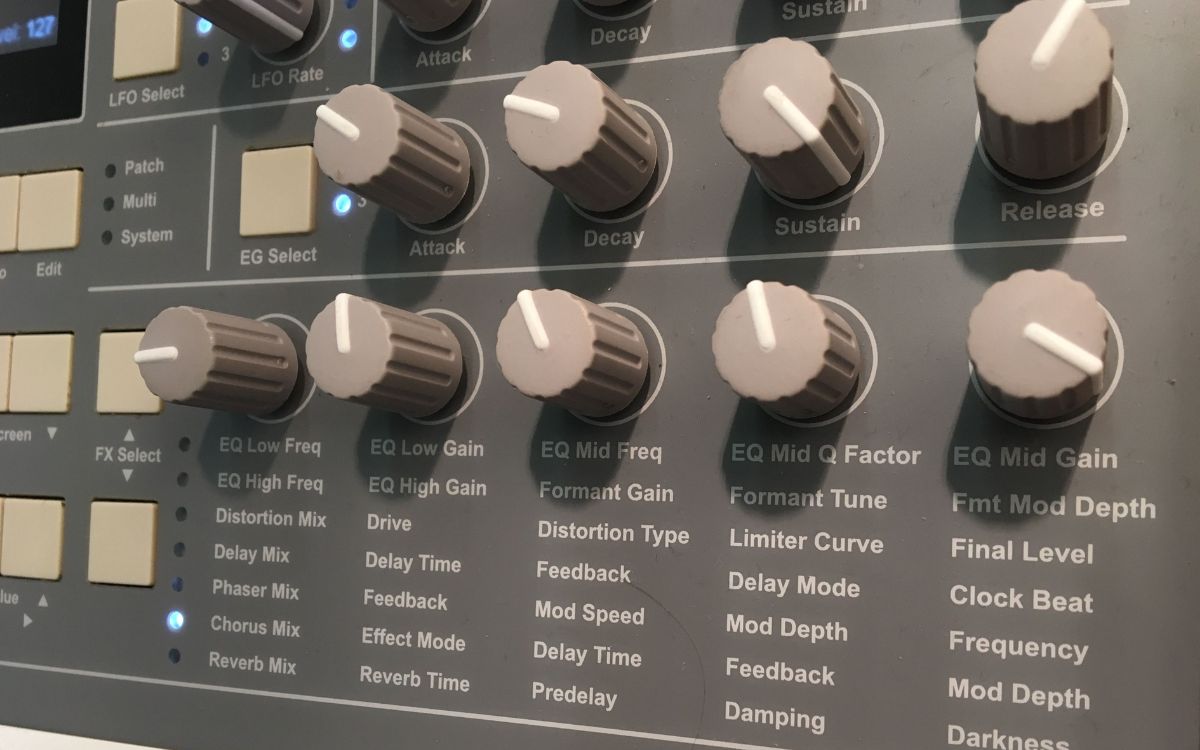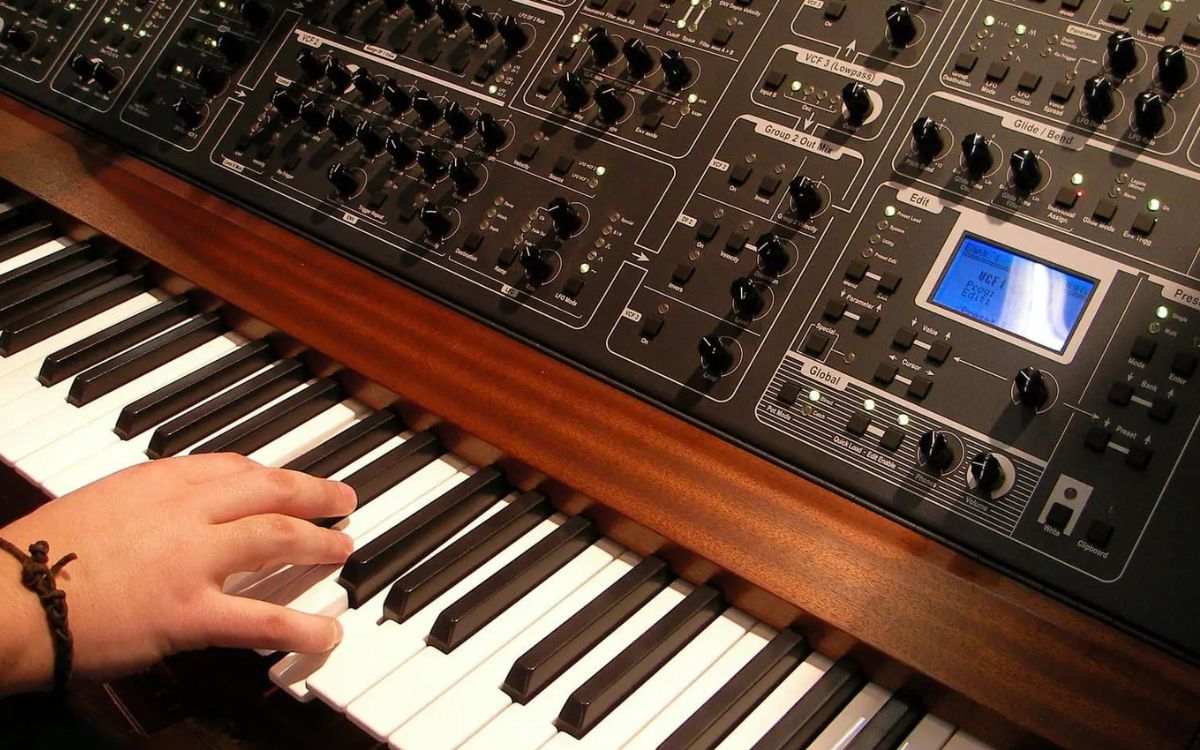Home>Instruments>Synthesizer>What Does A Synthesizer Oscillator Look Like


Synthesizer
What Does A Synthesizer Oscillator Look Like
Modified: February 20, 2024
Discover how the oscillators in a synthesizer create unique sounds. Get an inside look at the anatomy of a synthesizer oscillator with this comprehensive guide.
(Many of the links in this article redirect to a specific reviewed product. Your purchase of these products through affiliate links helps to generate commission for AudioLover.com, at no extra cost. Learn more)
Table of Contents
- Introduction
- Brief Explanation of a Synthesizer Oscillator
- Components of a Synthesizer Oscillator
- Voltage-Controlled Oscillator (VCO)
- Waveforms Generated by a Synthesizer Oscillator
- Frequency Control of a Synthesizer Oscillator
- The Role of Oscillator in Sound Synthesis
- Types of Synthesizer Oscillators
- Advancements in Oscillator Design
- Conclusion
Introduction
Welcome to the fascinating world of synthesizers! If you’ve ever listened to electronic music or wondered about the mesmerizing sounds behind your favorite songs, chances are you’ve encountered a device called a synthesizer. Synthesizers are electronic musical instruments that generate a wide variety of sounds through the manipulation of electrical signals.
One of the key components that make up a synthesizer is the oscillator. The oscillator is responsible for generating the raw audio signal that forms the basis of the sound produced by the synthesizer. Think of it as the heartbeat of the instrument, as it sets the tone and pitch of the sound.
In this article, we will delve into the world of synthesizer oscillators and unravel their secrets. We will explore the different components that make up an oscillator, the various types of waveforms they produce, and the role they play in sound synthesis. We will also touch upon advancements in oscillator design and how they have shaped the modern sound of synthesizers.
Whether you are a seasoned musician, a curious enthusiast, or simply someone interested in learning more about the inner workings of synthesizers, this article will serve as a comprehensive guide to understanding synthesizer oscillators. So, let’s dive in and explore the captivating world of these fascinating sound generators!
Brief Explanation of a Synthesizer Oscillator
Before we delve deeper into the intricacies of a synthesizer oscillator, let’s start with a brief explanation of what it actually is. At its core, an oscillator is an electronic circuit that generates an electrical waveform with a specific frequency and shape.
In the context of a synthesizer, the oscillator is responsible for creating the primary sound wave that will be shaped and manipulated to produce various tones and textures. It acts as the sound source, providing the foundation for creating melodies, chords, and intricate soundscapes.
The oscillator produces periodic waveforms, which can be thought of as a repeating pattern of electrical voltage over time. These waveforms can have different shapes, such as sine waves, square waves, triangle waves, and sawtooth waves, each with its own unique sonic characteristics.
The pitch of the sound generated by the oscillator is determined by the frequency of the waveform. Higher frequencies produce higher pitches, while lower frequencies produce lower pitches. The oscillator allows musicians and sound designers to precisely control and adjust the pitch of the generated sound, either manually or through external control signals.
In addition to pitch control, synthesizer oscillators often come equipped with various modulation options. Modulation refers to the ability to alter certain aspects of the waveform over time. This can include changing the frequency, amplitude, or shape of the waveform, resulting in dynamic and evolving sounds.
Now that we have a basic understanding of what a synthesizer oscillator is and what it does, let’s explore the individual components that make up this crucial part of the synthesizer.
Components of a Synthesizer Oscillator
A synthesizer oscillator consists of several key components that work together to generate the desired audio waveform. Let’s take a closer look at these components:
- Waveform Generator: This component is responsible for producing the basic waveform shape of the oscillator output. It can generate a variety of waveforms, such as sine waves, square waves, triangle waves, and sawtooth waves. The choice of waveform greatly impacts the timbre and character of the synthesizer’s sound.
- Frequency Control: The frequency control component allows for precise tuning of the oscillator. It enables musicians and sound designers to adjust the pitch of the generated sound, either manually or through external control signals. This control can be continuous or discrete, depending on the oscillator design.
- Amplitude Control: The amplitude control component determines the volume or loudness of the oscillator output. It allows users to shape the attack, sustain, decay, and release characteristics of the sound. Some oscillators also offer additional features like exponential or linear voltage control of the amplitude.
- Modulation Inputs: Modulation inputs play a crucial role in adding complexity and variation to the oscillator output. These inputs allow for the application of external control signals, such as envelopes, LFOs (Low-Frequency Oscillators), or other modulating sources, to modulate parameters such as frequency, amplitude, or waveform shape. This modulation capability greatly enhances the versatility and expressive potential of the synthesizer.
- Sync and FM Controls: Sync and Frequency Modulation (FM) controls are additional features found in some synthesizer oscillators. Sync allows for the synchronization of multiple oscillators, ensuring that they start and stop together. FM, on the other hand, enables the use of one oscillator to modulate the frequency of another oscillator, resulting in rich and complex harmonic interactions.
These components work in harmony, allowing musicians and sound designers to shape and sculpt the sound generated by the synthesizer oscillator to achieve desired musical effects and create a vast array of sounds and textures. The flexibility and control offered by these components make synthesizer oscillators an indispensable tool in music production and sound design.
Voltage-Controlled Oscillator (VCO)
A key type of oscillator used in synthesizers is the Voltage-Controlled Oscillator (VCO). As the name suggests, the VCO’s frequency is controlled by a voltage input, allowing for precise and dynamic pitch control.
The VCO typically consists of three main components:
- Core Oscillator: This is the heart of the VCO, generating the basic waveform shape. It can produce various waveforms, including the common ones like sine, square, triangle, and sawtooth waves.
- Exponential Converter: The exponential converter is responsible for converting the linear voltage input into an exponential control voltage. This conversion makes the pitch changes more perceptually equal, which means that equal voltage changes correspond to equal changes in pitch throughout the audible spectrum.
- Frequency Control: This component allows users to manipulate the VCO’s frequency by applying a control voltage. It can be adjusted manually using a potentiometer or controlled by external devices like keyboards or sequencers. The voltage input determines the speed at which the core oscillator produces the waveform cycles, thus directly affecting the pitch.
The frequency range of a VCO can typically span a wide range, from sub-audio frequencies to frequencies well beyond the human hearing range. This versatility allows for the creation of deep bass sounds, piercing leads, and everything in between.
One notable feature of VCOs is the ability to introduce pitch modulation. This modulation can be achieved through various methods, such as using an LFO or an envelope generator. Modulating the VCO’s frequency adds movement and variation to the sound, resulting in dynamic and evolving timbres.
VCOs are vital building blocks in modular synthesizer systems, as they offer tremendous flexibility and creative possibilities. By adjusting the frequency control, waveform shape, and modulation sources, musicians and sound designers can craft unique and expressive sounds that add depth and character to their compositions.
Overall, the Voltage-Controlled Oscillator is an essential component in any synthesizer, providing the foundation for creating diverse musical tones and textures. Its voltage-based control and modulation capabilities make it a powerful tool for sonic exploration and expression.
Waveforms Generated by a Synthesizer Oscillator
A synthesizer oscillator is capable of generating various waveforms, each with its own unique sonic characteristics. These waveforms serve as the raw material for creating different sounds and textures in electronic music. Let’s explore some of the most common waveforms produced by a synthesizer oscillator:
- Sine Wave: The sine wave is the purest and simplest waveform. It has a smooth, rounded shape and produces a clean, mellow tone. Sine waves are often used for creating smooth and gentle sounds like flute-like tones or choir-like sounds.
- Square Wave: The square wave has a distinct square-like shape, with equal time spent at the high and low voltage levels. It produces a rich and buzzy sound, rich in harmonics. Square waves are commonly used for creating percussive sounds, basslines, and electronic lead sounds.
- Triangle Wave: The triangle wave has a triangular shape, smoothly transitioning between high and low voltage levels. It produces a softer and smoother sound compared to the square wave. Triangle waves are often used for creating bell-like tones, pads, and brass sounds.
- Sawtooth Wave: The sawtooth wave has a distinctive saw-like shape, with a sharp rise and a gradual fall. It has a bright and sharp sound, rich in harmonics. Sawtooth waves are widely used for creating powerful bass sounds, lead sounds, and rich evolving textures.
These waveforms can be further manipulated through various modulation techniques to create even more complex and unique sounds. Modulation can involve altering the frequency, amplitude, or shape of the waveforms in real-time, allowing for dynamic and expressive sound design.
It’s worth noting that many synthesizers provide additional waveforms beyond these basic types, such as pulse waves, wavetables, or user-defined waveforms. These expanded options offer even more creative possibilities for crafting sounds that stand out in the mix.
Understanding the characteristics of different waveforms is essential for shaping the overall tone and timbre of a synthesizer sound. By experimenting with different waveforms and combinations of modulation, musicians and sound designers can unlock a world of sonic possibilities and create unique sonic signatures in their music.
Frequency Control of a Synthesizer Oscillator
The frequency control of a synthesizer oscillator is a crucial aspect that allows musicians and sound designers to precisely adjust the pitch of the generated sound. This control enables the creation of melodies, harmonies, and intricate musical arrangements. Let’s explore the various methods and techniques used for controlling the frequency of a synthesizer oscillator:
- Manual Control: Many synthesizers provide a dedicated knob or slider that allows for manual control of the oscillator’s frequency. By adjusting this control, users can change the pitch of the generated sound in real-time. This hands-on approach provides immediate and intuitive control over the musical expression.
- Keyboard Control: One of the most common methods of frequency control in a synthesizer is through a keyboard. By connecting a keyboard to the synthesizer, the musician can control the pitch of the oscillator by playing different keys. As they press higher or lower keys, the frequency of the oscillator changes accordingly, producing different pitches.
- Sequencer Control: In addition to manual and keyboard control, synthesizers often include built-in sequencers or allow for external sequencer integration. A sequencer allows users to program a series of pitches or notes, which can be played back in a predetermined sequence. This method of control enables precise pitch sequences and repetitive patterns.
- External Control: Synthesizer oscillators can also be controlled externally through various means. This can include control voltages generated by other modules in a modular synthesizer setup, MIDI (Musical Instrument Digital Interface) signals sent from a computer or external MIDI controller, or even CV/Gate signals from vintage analog synthesizers.
- Modulation: Frequency modulation (FM) is a powerful technique used for shaping the characteristics of a sound. In FM synthesis, one oscillator modulates the frequency of another oscillator. This modulation creates harmonically complex timbres and allows for the creation of rich and evolving sounds.
The techniques mentioned above can be used individually or in combination to achieve precise and expressive control over the frequency of a synthesizer oscillator. This control not only allows for melodic expression but is also instrumental in creating unique textures and soundscapes.
Whether it’s through manual control, keyboard playing, sequencing, or external modulation, the frequency control of a synthesizer oscillator empowers musicians and sound designers to shape their musical ideas and bring them to life.
The Role of Oscillator in Sound Synthesis
In the realm of sound synthesis, the oscillator plays a fundamental role in shaping the sonic landscape. It serves as the primary sound source, generating the raw audio waveform that forms the basis of the sound produced by a synthesizer. Let’s explore the important roles that oscillators play in sound synthesis:
- Sound Generation: The oscillator is responsible for creating the initial sound wave. It generates periodic waveforms of various shapes, such as sine waves, square waves, triangle waves, or sawtooth waves. These waveforms provide the foundation for creating musical tones and textures.
- Pitch Control: The oscillator allows for precise control over the pitch of the generated sound. By adjusting the frequency of the oscillator, which determines the speed of the waveform cycles, musicians and sound designers can create different pitches, ranging from low bass tones to high-frequency sounds. This control enables them to create melodies, harmonies, and chord progressions.
- Timbre Shaping: Oscillators contribute significantly to the timbre, or tone color, of a sound. The different waveform shapes produced by oscillators have distinct sonic characteristics. By selecting and combining different waveforms, and applying modulation or filtering techniques, musicians can shape and sculpt the timbre of the sound. This allows for the creation of a wide range of sounds, from smooth and mellow tones to harsh and edgy textures.
- Modulation Source: Oscillators often serve as modulation sources in sound synthesis. They can generate control voltages or signals that modulate various parameters of a sound, such as amplitude, frequency, or waveform shape. This modulation capability adds movement, complexity, and expressiveness to the sound, enabling the creation of dynamic and evolving tones.
- Layering and Texturing: Multiple oscillators can be used together to layer sounds and create complex textures. Each oscillator can have its own frequency, waveform shape, and modulation settings. By combining these oscillators, musicians can generate rich and layered sounds that add depth and complexity to their compositions.
Overall, the oscillator is a critical component in sound synthesis, providing the foundational elements for shaping musical tones. Its ability to generate waveforms, control pitches, shape timbres, and modulate sounds makes it an indispensable tool for musicians and sound designers. Whether it’s creating a simple melody, layering complex textures, or exploring experimental sonic territories, the oscillator plays a central role in shaping and defining the sonic palette of synthesized music.
Types of Synthesizer Oscillators
Synthesizer oscillators come in various types, each offering unique sonic characteristics and creative possibilities. Let’s explore some of the most common types of synthesizer oscillators:
- Analog Oscillators: Analog oscillators are based on analog electronic circuits and are often found in vintage and modern analog synthesizers. They produce rich, warm, and organic sounds due to the inherent nonlinearities and imperfections of analog circuitry. Analog oscillators can generate a variety of waveforms, including sine waves, square waves, triangle waves, and sawtooth waves.
- Digital Oscillators: Digital oscillators use digital signal processing techniques to generate waveforms. They offer a wide range of waveforms and often provide additional features like wavetable synthesis, granular synthesis, or virtual analog modeling. Digital oscillators can produce precise and pristine sounds and offer extensive control and modulation options.
- Phase-Modulation (PM) Oscillators: Phase modulation oscillators are a form of frequency modulation (FM) synthesis, popularized by Yamaha’s DX series synthesizers. They use mathematical algorithms to modulate the phase of a carrier waveform with a modulator waveform. PM oscillators are known for producing complex timbres, including metallic, bell-like, and percussive sounds.
- Wavetable Oscillators: Wavetable oscillators generate waveforms by playing back pre-recorded samples stored in a wavetable. Each sample represents a snapshot of a waveform at a specific point in time. Wavetable oscillators offer a vast range of timbral possibilities, as they can smoothly interpolate between different wavetables and create evolving textures and morphing sounds.
- Physical Modeling Oscillators: Physical modeling oscillators simulate the behavior of acoustic instruments through mathematical models. They allow for realistic recreations of instruments like pianos, guitars, or drums. Physical modeling oscillators are highly expressive and can emulate the intricate nuances and articulations of acoustic instruments.
- Modular Oscillators: Modular synthesizers provide a modular approach to sound synthesis, allowing users to mix and match various modules to create custom systems. Modular oscillators can come in different types, including analog, digital, or hybrid designs, offering complete flexibility for sound creation and experimentation.
These different types of synthesizer oscillators offer a wide range of sonic possibilities, from vintage analog warmth to cutting-edge digital precision. The choice of oscillator type depends on the desired sound aesthetics, functionality, and the specific creative goals of the musician or sound designer.
It’s worth noting that some synthesizers incorporate multiple types of oscillators, allowing users to combine the unique characteristics of each oscillator type in their sound design. This provides even greater flexibility and sonic versatility, enabling musicians to create signature sounds that are inherently their own.
Advancements in Oscillator Design
The world of oscillator design has seen significant advancements over the years, driven by technological progress and the pursuit of new and innovative sounds. These advancements have shaped the landscape of synthesizers and opened up new possibilities for musicians and sound designers. Let’s explore some of the key advancements in oscillator design:
- Digital Oscillator Technology: The advent of digital technology revolutionized oscillator design. Digital oscillators offer precise control, extensive modulation capabilities, and the ability to store and recall presets. They can accurately reproduce a wide range of waveforms and provide advanced synthesis techniques like wavetable synthesis, frequency modulation, and physical modeling. Digital oscillators have opened up new horizons in sound synthesis, allowing for complex and evolving sounds that were previously unimaginable.
- Improved Stability and Tuning: Historically, analog oscillators were prone to frequency drift and tuning instability due to the nature of analog electronics. However, advancements in technology and circuit design have led to improved stability and tuning accuracy. Modern analog oscillators implement temperature compensation, precision voltage-controlled oscillators, and digital tuning algorithms, ensuring stable and accurate frequency control.
- Expanded Waveform Options: Traditional synthesizers typically offered a limited selection of basic waveforms, such as sine, square, triangle, and sawtooth waves. However, modern oscillators provide a much wider range of waveform options. They can include complex wavetables, user-defined waveforms, and even the ability to create and import custom waveforms. This expanded palette of waveforms allows for greater sonic experimentation and creativity.
- Enhanced Modulation Capabilities: Oscillators now offer advanced modulation capabilities, allowing for complex and dynamic sound shaping. These advancements include multi-stage envelope generators, LFO synchronization, and extensive modulation routing options. This level of control enables musicians to create evolving and expressive sounds with intricate modulation patterns and interactions.
- Integration of Digital and Analog Hybrid Designs: Many modern synthesizers combine the best of both digital and analog worlds by incorporating hybrid oscillator designs. These oscillators utilize digital technology for precise control, extensive modulation options, and complex synthesis techniques, while also retaining the warmth and character of analog circuitry. This hybrid approach provides a unique sonic blend and offers the best of both worlds to musicians and sound designers.
These advancements in oscillator design have transformed the capabilities of synthesizers, enabling musicians and sound designers to create a vast array of sounds and textures. They have propelled sound synthesis into new realms, pushing the boundaries of musical expression and fostering innovation in electronic music.
As technology continues to evolve, we can anticipate further advancements in oscillator design, continually expanding the sonic possibilities and pushing the limits of creativity in sound synthesis.
Conclusion
Synthesizer oscillators play a critical role in shaping the soundscape of electronic music. They generate the foundational waveforms that serve as the building blocks for melodies, harmonies, and intricate sonic textures. Through advancements in design and technology, oscillators have evolved to offer musicians and sound designers a wide range of creative possibilities.
From analog oscillators with their warm and organic tones to digital oscillators with precise control and extensive modulation options, the variety of oscillator types available provides musicians with a diverse sonic palette to explore. The ability to manipulate waveform shapes, control frequencies, and apply modulation techniques allows for the creation of unique and expressive sounds.
Oscillator design has seen significant progress with the incorporation of digital technology, resulting in improved stability, expanded waveform options, and enhanced modulation capabilities. Hybrid designs further combine the strengths of digital and analog technologies, offering the best of both worlds in terms of control and sonic character.
As synthesizers continue to evolve, oscillators will likely play an even more vital role in empowering musicians to craft innovative and captivating sonic experiences. The constant pursuit of new sounds and techniques will continue to push the boundaries of sound synthesis, making music creation an ever-evolving artform.
Whether you’re a musician exploring the depths of sound design or a curious enthusiast seeking to understand the inner workings of synthesizers, understanding oscillators is a crucial step in unlocking the full potential of these powerful instruments.
So, dive in, experiment, and let the oscillators guide you on a sonic journey filled with endless possibilities and creative expression!











